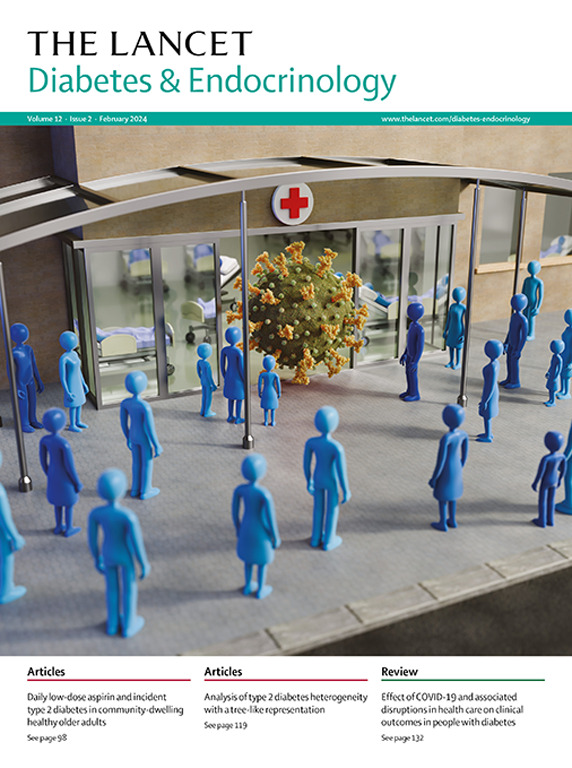Setmelanotide in patients aged 2–5 years with rare MC4R pathway-associated obesity (VENTURE): a 1 year, open-label, multicenter, phase 3 trial
IF 44
1区 医学
Q1 ENDOCRINOLOGY & METABOLISM
引用次数: 0
Abstract
Background
Setmelanotide, a melanocortin-4 receptor (MC4R) agonist, has been shown to reduce hunger and weight in patients aged 6 years and older with proopiomelanocortin (POMC) deficiency (including biallelic variants in proprotein convertase subtilisin/kexin type 1 [PCSK1]), leptin receptor (LEPR) deficiency, or Bardet-Biedl syndrome (BBS). No approved therapies for patients younger than 6 years old currently exist. The phase 3, open-label VENTURE trial aimed to evaluate the efficacy and safety of setmelanotide in patients aged 2–5 years with POMC or LEPR deficiency or BBS.Methods
This phase 3, open-label, multicentre trial, conducted across six sites in the USA, the UK, Spain, and Australia, enrolled eligible patients aged 2–5 years who had hyperphagia and obesity due to biallelic POMC (including PCSK1) or LEPR variants or genetically confirmed BBS. Open-label subcutaneous setmelanotide was administered once daily for 52 weeks, starting at 0·5 mg with doses increasing every 2 weeks in 0·5 mg increments until reaching the maximum dose based on weight. The co-primary endpoints at week 52 were the percentage of patients reaching a 0·2-point decrease or greater in BMI Z score (a statistical measure used to assess BMI in paediatric patients considering a patient's BMI and comparing it to reference values for the same age and sex) and mean percent change in BMI. Additional endpoints measured safety, hunger, weight-related outcomes, and caregiver burden. The study is registered at ClinicalTrials.gov (NCT04966741) and is complete.Findings
Between March 8, 2022, and Sept 18, 2023, 13 patients were screened at the six sites, and 12 patients were enrolled in the study (seven with POMC or LEPR and five with BBS); one patient with BBS was excluded as their BMI was not at the 97th percentile or above. Of the 12 patients enrolled, most were male (seven [58%] vs five [42%] for female) and the mean age was 3·6 years (SD 0·9). 11 patients completed the trial. Ten (83%) of the 12 overall participants reached a 0·2-point reduction or more in BMI Z score per WHO methodology at week 52 (95% CI 58·7–99·8). The mean percent change in BMI from baseline at week 52 was −18% (SD 13) in the overall safety population. Mean percent change in BMI at week 52 was −26% (SD 11) in patients with POMC or LEPR deficiency and −10% (9) in patients with BBS. Mean reductions in secondary endpoints of BMI Z score (3·4 [2·5]) and percent of the BMI 95th percentile (32·5 [22·9]) were seen at Week 52. 91% of caregivers reported that patients were less hungry than at baseline. All adverse events were mild or moderate; skin hyperpigmentation, vomiting, nasopharyngitis, upper respiratory tract infection, and injection site reactions were most common. No serious adverse events or adverse events leading to study discontinuation or death were reported.Interpretation
To our knowledge this is the first trial of setmelanotide in patients younger than 6 years old. These results support the benefit of the drug as an early intervention to manage obesity in this population.Funding
Rhythm Pharmaceuticals.塞美拉诺肽治疗 2-5 岁罕见 MC4R 通路相关肥胖症患者(VENTURE):为期 1 年的开放标签多中心 3 期试验
背景塞美拉诺肽是一种黑色素皮质素-4受体(MC4R)激动剂,已被证明可减轻6岁及以上原绒毛膜促皮质素(POMC)缺乏症(包括1型丙蛋白转化酶亚基酶/kexin [PCSK1]的双倍变体)、瘦素受体(LEPR)缺乏症或巴尔德-比德综合征(BBS)患者的饥饿感和体重。目前还没有针对 6 岁以下患者的获批疗法。这项 3 期开放标签 VENTURE 试验旨在评估 Setmelanotide 对 2-5 岁 POMC 或 LEPR 缺乏症或 BBS 患者的疗效和安全性。方法这项 3 期开放标签多中心试验在美国、英国、西班牙和澳大利亚的六个地点进行,招募了符合条件的 2-5 岁患者,这些患者因双唇 POMC(包括 PCSK1)或 LEPR 变异或基因证实的 BBS 而导致吞咽功能亢进和肥胖。开放标签皮下注射塞美拉诺肽,每天一次,持续52周,起始剂量为0-5毫克,每2周剂量增加0-5毫克,直至达到基于体重的最大剂量。第52周的共同主要终点是BMI Z评分(一种用于评估儿科患者BMI的统计方法,考虑患者的BMI并将其与同年龄和性别的参考值进行比较)下降0-2分或更多的患者比例以及BMI平均变化百分比。其他终点指标包括安全性、饥饿感、体重相关结果和护理负担。研究结果2022年3月8日至2023年9月18日期间,6个研究机构共筛查了13名患者,12名患者被纳入研究(7名患有POMC或LEPR,5名患有BBS);1名患有BBS的患者因其BMI未达到或超过97百分位数而被排除在外。在这12名患者中,大多数为男性(7名[58%],5名[42%]为女性),平均年龄为3-6岁(SD 0-9)。11 名患者完成了试验。根据世界卫生组织的方法,在第 52 周时,12 名参与者中有 10 人(83%)的体重指数 Z 值下降了 0-2 点或更多(95% CI 58-7-99-8)。总体安全人群在第 52 周时的 BMI 与基线相比的平均百分比变化为-18%(标度 13)。第52周时,POMC或LEPR缺乏症患者的BMI平均变化百分比为-26%(标准差11),BBS患者的BMI平均变化百分比为-10%(标准差9)。第52周时,次要终点BMI Z评分(3-4 [2-5])和BMI第95百分位数百分比(32-5 [22-9])的平均值均有所下降。91%的护理人员表示患者的饥饿感低于基线值。所有不良反应均为轻度或中度;皮肤色素沉着、呕吐、鼻咽炎、上呼吸道感染和注射部位反应最为常见。据我们所知,这是首次在 6 岁以下患者中进行赛美拉诺肽试验。据我们所知,这是首次在 6 岁以下患者中开展的试验,这些结果表明,该药物可作为早期干预措施用于控制这类人群的肥胖症。
本文章由计算机程序翻译,如有差异,请以英文原文为准。
求助全文
约1分钟内获得全文
求助全文
来源期刊

The Lancet Diabetes & Endocrinology
ENDOCRINOLOGY & METABOLISM-
CiteScore
61.50
自引率
1.60%
发文量
371
期刊介绍:
The Lancet Diabetes & Endocrinology, an independent journal with a global perspective and strong clinical focus, features original clinical research, expert reviews, news, and opinion pieces in each monthly issue. Covering topics like diabetes, obesity, nutrition, and more, the journal provides insights into clinical advances and practice-changing research worldwide. It welcomes original research advocating change or shedding light on clinical practice, as well as informative reviews on related topics, especially those with global health importance and relevance to low-income and middle-income countries. The journal publishes various content types, including Articles, Reviews, Comments, Correspondence, Health Policy, and Personal Views, along with Series and Commissions aiming to drive positive change in clinical practice and health policy in diabetes and endocrinology.
 求助内容:
求助内容: 应助结果提醒方式:
应助结果提醒方式:


